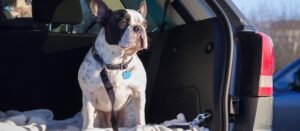By Dr. Beth Leermakers
Most people don’t think twice about wearing a seatbelt or strapping their toddler into a car seat every time they drive somewhere. Yet many people routinely skip these car safety measures for their dogs. According to a 2018 study, 97 percent of dog parents travel in a car with their pet, but only 48 percent have car safety gear. Forty one percent of pet parents let their pooch ride in the front seat — where air bags aren’t designed to protect dogs.

After having a 70-lb. lab knock my car out of gear while he scrambled from the shotgun seat toward my lap, I now put my new foster dogs in a crate. Crating them also simplifies cleanup if the dog throws up or goes to the bathroom on the way to the vet or meet and greet. However, I don’t use a crate when I take my personal dogs on road trips. Although tethering them in the back of my SUV keeps the 60-pounders out of my lap while I’m driving, it doesn’t protect them if I suddenly slam on the brakes.
Dogs should be restrained in the car to keep them — and you — safe if you’re in an accident. Car safety features are designed for the weight and body position of humans — not pets. Loose dogs can be a distraction, which causes you to have an accident, and they can hurt you and themselves if they’re flying around in your car after a sudden stop, swerve or collision. If you have a crash at 50 mph, a 10-lb loose dog generates 500 pounds of projectile force. In a 30-mph crash, an 80-pound dog becomes a 2400-pound airborne projectile.
Restraining your dog in the car also helps if your dog gets car sick. A dog seat belt, car seat or crate minimizes sudden movements or a change in position that may trigger nausea.
Here are four options to protect your dog in the car:
Dog seat belt. Dog car seat belts attach a full-body car safety harness to a strap with a buckle that fits in the regular seat belt device of your car. You should never pass a seatbelt through a regular harness or collar. Instead, use a car safety harness that fits securely around your dog’s body. You should be able to easily slip two fingers around the collar, under the back and around the armpits. The straps that buckle into the dog car harness should be long enough that the dog is comfortable, though short enough to prevent him from crashing into the seat in front of him in the event of an accident.
Although dog seat belts work for both small and large dogs, they’re best for larger dogs. Seat belts may not be the most comfortable option for tiny dogs. Crates or carriers are the best option for toy breeds.
Crate or carrier. Crating your dog is the best way to keep her safely inside your car and prevent trauma. Kenneled dogs involved in high-speed accidents are more likely to survive with fewer injuries. If you’re in a serious accident, there’s less risk of your dog fleeing the scene in panic, which can lead to him getting lost or hit by a car. Crates and carriers are also better restraint options for animals with back or neck injuries — to avoid sudden pressure on the back or neck from a harness if you brake suddenly. Be sure to securely fasten the carrier (for smaller dogs) to the car seat so it can’t move around. Crates that can be secured to the car seat or in the back of an SUV are good options for larger dogs. The crate should be just big enough for your dog to stand up, lie down and turn around.
Booster Dog Car seat. Dog car seats are ideal for small and medium dogs — as long as the seat belt attachment is adjusted to keep your dog from moving out of the booster seat. The booster seat should be placed in the back seat, like a child’s booster seat. Having your dog in the front seat is often a distraction, and there’s a greater risk of injury in an accident. If your dog is in the front seat, turn off the passenger air bag to prevent it from being deployed and hurting your pup if you’re in an accident.
Dog Car Barriers. A barrier works well to keep your dog in the back of larger vehicles such as SUVs, but it can also be used to separate the front and back seats in any size car — keeping your dog out of your lap.
Car barriers are good options for extra-large dogs that can’t be restrained on the seat or in a crate.
Visit the Center for Pet Safety (centerforpetsafety.org/test-results/) to read reviews of the crashworthiness of various pet restraints, including dog car seats, seat belts, and crates and carriers. They test travel harnesses, carriers and crates, using crash-test-dummy dogs. Look for products that have the “Center for Pet Safety Certified” logo.
Whatever method you use to restrain your pet in the car, never leave him alone in the car, even with the windows cracked. Even when it’s only 72 degrees outside, your dog’s internal body temperature can rise more than 40 degrees in less than an hour. Extreme cold weather can also be dangerous.
If you’re running errands, leave your pet at home, or have someone stay in the car with them.
Happy Trails (and tails)!
